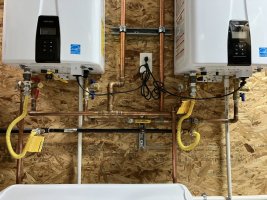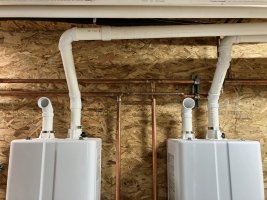Jughead135
New Member
New to the forum (great site!), and I'm nobody's plumber. Trying to figure out how best to use the WHs in my new home. Pics attached.
Existing DHW install in new home: 2x Navien NPE-240A2 units, side by side, wall mounted. Water supplied by well. Single cold water supply line, "T"-valve supplies both heaters. Another "T"-valve combines the output of each to a single hot water line. Separate intake & exhaust venting for each. NO recirculation return line installed (new construction--**slaps forehead**). NO communication line installed between them. Shortly after the "T"-valve, the hot (and cold) water supply lines split and supply two distinct areas of the house (with further splits visible before the lines disappear into the walls, but not enough to account for every output, so obviously more splitting downstream).
Q1) Are these two "working together" in any sense? Will I improve the operation with the addition of the Ready-Link Cascade Cable? That appears to be simple plug-in wiring & menu configuration--no plumbing, correct?
Q2) I note that the cold water supply line entering one or both WHs gets hot, a consequence (I assume) of how they're plumbed. Is this a problem? I suspect it's due to using RECIRC mode (in internal). Am I missing some check valves (perhaps one each on the cold water supply lines to each unit)? Does that apply to the A2 units w/ return via the main supply line & not the recirc connector? [As seen in the pics, I currently have recirc turned off & one unit completely powered down / water off for troubleshooting. This issue has NOT recurred in this configuration.]
Q3) Despite enabling the internal recirculation, it takes a long time to get hot water. I assume the NaviCirc bypass valve is the way to go in my situation (no recirc return line plumbed in the house)? I'm finding conflicting/confusing information on how those are installed:
Q4) NaviCirc: Is there plumbing required at the heater(s) to connect from the cold water supply line (to be used as a return) to the recirculation inlet fitting? [I gather that's NOT required for my A2 units, but IS required for the A--a point of considerable confusion!] If so, should that be to one or both units? If not, will I need some sort of check valve in the supply line so the recirculating water goes into the heater and no chance of backflowing the well; or does the action of the reirc pump take care of that?
Q4) NaviCirc: Given the two major "zones" of the house being fed by both the cold & hot water supplies, would I then want to install TWO (or more) bypass valves, one at the distant end of each zone? Or perhaps at the "most important" point, not necessarily farthest? [Thinking master bedroom & kitchen.] Will such a setup require fancier plumbing, or will it "just work"? I've seen this question asked & answered elsewhere on the forum--would doing do necessitate additional check valves at each point of installation? Should recirculation be enabled on both units, or only one?
Q5) Large house, generally only occupied by two of us--but frequently full-up on visitors. Considering Q1 above (Ready-Link Cascade Cable), would I be better off getting them "talking" to each other, or simply manually running a single unit, turning the other one on & off as required for larger groups? Or maybe both will be needed in winter? (We've never exceeded the capacity during our short time here--but, both units were running during the cold months.) Will the cable "shut down" one unit? How does mixing heated water with cold (from the non-operative heater) achieve fully-heated water?
Q6) Just how hot ("warm"; "tepid"; pick your adjective) is my *cold* water going to get, and how long to get cold? I'm particularly sensitive in the kitchen, where we have drinking water & two ice makers (freezer & a stand-alone)--feeding heated water to those taps just doesn't seem like a good idea....
Please note: I'm looking at the "Quick Installation Guide," Step 6 on p. 2., found at https://www.navieninc.com/downloads/npe-2-quick-installation-guide-en. I believe the diagrams may be mis-matched?? The detailed diagram under "...using the Cold Water Inlet" appears to describe the "...using the Recirculation Inlet," and vice-versa; whereas the simplified diagrams under each heading appear to be correct (and not match the detailed ones). This is a large part of my confusion, so please set me straight....
Love the system, but I'm pretty sure I'm not getting all I can out of it at the moment. Happy to provide more pics if needed. Thanks for any help or pointers you can provide!
Existing DHW install in new home: 2x Navien NPE-240A2 units, side by side, wall mounted. Water supplied by well. Single cold water supply line, "T"-valve supplies both heaters. Another "T"-valve combines the output of each to a single hot water line. Separate intake & exhaust venting for each. NO recirculation return line installed (new construction--**slaps forehead**). NO communication line installed between them. Shortly after the "T"-valve, the hot (and cold) water supply lines split and supply two distinct areas of the house (with further splits visible before the lines disappear into the walls, but not enough to account for every output, so obviously more splitting downstream).
Q1) Are these two "working together" in any sense? Will I improve the operation with the addition of the Ready-Link Cascade Cable? That appears to be simple plug-in wiring & menu configuration--no plumbing, correct?
Q2) I note that the cold water supply line entering one or both WHs gets hot, a consequence (I assume) of how they're plumbed. Is this a problem? I suspect it's due to using RECIRC mode (in internal). Am I missing some check valves (perhaps one each on the cold water supply lines to each unit)? Does that apply to the A2 units w/ return via the main supply line & not the recirc connector? [As seen in the pics, I currently have recirc turned off & one unit completely powered down / water off for troubleshooting. This issue has NOT recurred in this configuration.]
Q3) Despite enabling the internal recirculation, it takes a long time to get hot water. I assume the NaviCirc bypass valve is the way to go in my situation (no recirc return line plumbed in the house)? I'm finding conflicting/confusing information on how those are installed:
Q4) NaviCirc: Is there plumbing required at the heater(s) to connect from the cold water supply line (to be used as a return) to the recirculation inlet fitting? [I gather that's NOT required for my A2 units, but IS required for the A--a point of considerable confusion!] If so, should that be to one or both units? If not, will I need some sort of check valve in the supply line so the recirculating water goes into the heater and no chance of backflowing the well; or does the action of the reirc pump take care of that?
Q4) NaviCirc: Given the two major "zones" of the house being fed by both the cold & hot water supplies, would I then want to install TWO (or more) bypass valves, one at the distant end of each zone? Or perhaps at the "most important" point, not necessarily farthest? [Thinking master bedroom & kitchen.] Will such a setup require fancier plumbing, or will it "just work"? I've seen this question asked & answered elsewhere on the forum--would doing do necessitate additional check valves at each point of installation? Should recirculation be enabled on both units, or only one?
Q5) Large house, generally only occupied by two of us--but frequently full-up on visitors. Considering Q1 above (Ready-Link Cascade Cable), would I be better off getting them "talking" to each other, or simply manually running a single unit, turning the other one on & off as required for larger groups? Or maybe both will be needed in winter? (We've never exceeded the capacity during our short time here--but, both units were running during the cold months.) Will the cable "shut down" one unit? How does mixing heated water with cold (from the non-operative heater) achieve fully-heated water?
Q6) Just how hot ("warm"; "tepid"; pick your adjective) is my *cold* water going to get, and how long to get cold? I'm particularly sensitive in the kitchen, where we have drinking water & two ice makers (freezer & a stand-alone)--feeding heated water to those taps just doesn't seem like a good idea....
Please note: I'm looking at the "Quick Installation Guide," Step 6 on p. 2., found at https://www.navieninc.com/downloads/npe-2-quick-installation-guide-en. I believe the diagrams may be mis-matched?? The detailed diagram under "...using the Cold Water Inlet" appears to describe the "...using the Recirculation Inlet," and vice-versa; whereas the simplified diagrams under each heading appear to be correct (and not match the detailed ones). This is a large part of my confusion, so please set me straight....
Love the system, but I'm pretty sure I'm not getting all I can out of it at the moment. Happy to provide more pics if needed. Thanks for any help or pointers you can provide!


